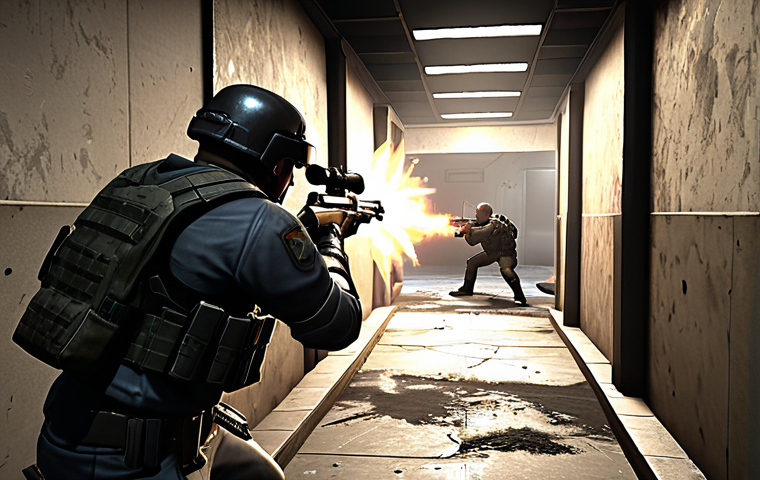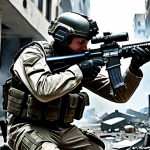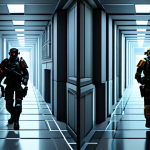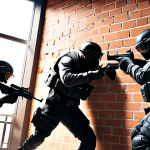Alright, here we go! Diving into the nitty-gritty of weapon characteristics in any game can be a total game-changer (pun intended!). We’re talking about understanding the subtle nuances that separate a decent loadout from a truly devastating one.
From the rapid-fire chaos of SMGs to the calculated precision of sniper rifles, each weapon archetype brings something unique to the table. Think about how recent game updates have tweaked weapon stats, shifting the meta and forcing players to adapt.
It’s not just about raw damage anymore; it’s about recoil control, effective range, and even the psychological impact a certain weapon has on your opponents.
Based on the latest trends, weapon customization is also becoming increasingly important, with players optimizing their gear for specific playstyles. Let’s delve deeper into the specifics in the article below.
Alright, let’s dive in!
Mastering the Arsenal: Beyond Stats and Figures

It’s easy to get caught up in the raw numbers – damage per second, time-to-kill, magazine size. But truly mastering the arsenal in any competitive game requires going far beyond the stat sheets.
It’s about understanding how these numbers translate into real-world scenarios, and how to leverage a weapon’s strengths to compensate for its weaknesses.
I’ve seen countless players, myself included, stubbornly stick to a weapon they *think* is good, only to get repeatedly outmaneuvered by someone who understands the game’s mechanics better.
Think of it like this: a high-damage sniper rifle is great, but completely useless in a close-quarters firefight in a dimly lit building. What if you’re up against a player using a shotgun at such close range?
I have personally felt the humiliation. Knowing when to switch weapons, or when to simply disengage and reposition, is just as critical as landing headshots.
The best players are adaptable, able to read the situation and adjust their loadout and tactics accordingly.
Unveiling Hidden Synergies: Attachment Combinations
Attachment combinations can also be a game-changer. I remember when the addition of a specific suppressor on a certain assault rifle completely altered its recoil pattern, making it a laser beam at medium range.
It’s these little details, often buried in patch notes or discovered through player experimentation, that can truly elevate your gameplay. Players will often pair scopes with guns that have high recoil, or add laser pointers for those close-up battles.
Map Awareness and Weapon Selection
Map awareness also plays a huge role in weapon selection. Knowing the chokepoints, the open areas, and the common engagement distances on a map will directly influence which weapons are most effective.
For example, you probably wouldn’t want to bring a shotgun to a map with long, open sightlines, unless you’re specifically trying to bait opponents into close-quarters engagements.
This all boils down to experience and adaptability, knowing what will work best in a given situation.
Personal Preference vs. Meta: Finding Your Groove
Lastly, don’t be afraid to experiment and find weapons that suit your personal playstyle, even if they aren’t considered “meta.” While following the meta can give you a competitive edge, you’ll ultimately perform better with weapons you’re comfortable and confident using.
I personally find that I do better with a high rate of fire weapon, and a low recoil weapon. Experimentation is key, and once you find your groove, you can be a deadly threat on the battlefield.
The Rock-Paper-Scissors of Weaponry: Countering Common Strategies
Every weapon has its counters, and understanding these matchups is essential for strategic gameplay. Think of it like a rock-paper-scissors game. Shotguns are powerful up close but get shredded at range by assault rifles, which in turn can be outgunned by snipers in open areas.
Machine guns are great for close range area control. Knowing these inherent advantages and disadvantages allows you to make informed decisions about when to engage, when to disengage, and when to switch weapons.
It’s not just about having good aim; it’s about having the tactical awareness to put yourself in the most advantageous position.
Leveraging Weaknesses: Identifying Enemy Loadouts
Identifying enemy loadouts and exploiting their weaknesses is a critical skill. If you notice an enemy player consistently using a shotgun, try to keep your distance and engage them from medium to long range.
Conversely, if you see someone with a sniper rifle, try to close the gap and force them into a close-quarters engagement. It’s all about anticipating their movements and forcing them into situations where their weapon of choice is less effective.
The skill ceiling is high, because the potential for outplay is also high.
Adaptability is Key: Switching Weapons on the Fly
Being able to quickly assess a situation and adapt your weapon choice accordingly is a sign of a skilled player. It’s not enough to simply stick to your preferred loadout; you need to be able to switch weapons on the fly to counter specific threats and take advantage of opportunities.
Mastering Movement: Closing the Distance
Movement is a crucial element in countering weapon disadvantages. Skilled players use advanced movement techniques like sliding, jumping, and strafing to close the distance on snipers or create space against shotguns.
Mastering these techniques requires practice and precision, but the payoff can be huge.
Recoil Control: Taming the Beast
Recoil is the bane of many players’ existence, but it’s also a key factor that separates the good from the great. Mastering recoil control allows you to consistently land shots, even at longer ranges, and significantly increases your damage output.
I remember spending hours in practice mode, simply firing at a wall to learn the recoil patterns of different weapons. It may seem tedious, but it’s an investment that pays off in spades.
Recoil can be vertical, horizontal, or a combination of both.
Understanding Patterns: Each Weapon’s Unique Signature
Each weapon has its own unique recoil pattern, and learning these patterns is the first step towards mastering recoil control. Some weapons have a predictable vertical recoil, while others have a more erratic horizontal or diagonal pattern.
Compensating Techniques: Pulling Down and Strafe Adjustments
There are several techniques you can use to compensate for recoil. The most common is simply pulling down on the mouse or controller to counteract the upward recoil.
However, for weapons with horizontal recoil, you may need to make small adjustments to your strafing movement to keep your shots on target.
Attachments Matter: Stabilizers and Foregrips
Attachments play a crucial role in recoil control. Stabilizers and foregrips can significantly reduce recoil, making it easier to land shots. Experiment with different attachments to find the combination that works best for your preferred weapons.
ADS vs. Hip Fire: When to Aim Down Sights
Knowing when to aim down sights (ADS) and when to hip fire is crucial for maximizing your effectiveness in combat. ADS provides increased accuracy and reduced recoil, but it also slows down your movement speed.
Hip firing, on the other hand, allows you to move more quickly but sacrifices accuracy. The choice between ADS and hip fire depends on the engagement distance, the weapon you’re using, and your personal playstyle.
Close Quarters Combat: The Hip Fire Advantage
In close-quarters combat, hip firing is often the better option. The increased movement speed allows you to dodge enemy fire and quickly reposition yourself.
Shotguns and SMGs are particularly effective when hip fired at close range.
Mid-to-Long Range Engagements: ADS for Precision
At mid-to-long range, ADS is essential for landing accurate shots. The increased accuracy and reduced recoil provided by ADS allow you to consistently hit your target, even at a distance.
Assault rifles and sniper rifles are best used when ADS at these ranges.
Situational Awareness: Combining ADS and Hip Fire
The best players are able to seamlessly transition between ADS and hip fire, depending on the situation. Learning to quickly switch between the two firing modes allows you to adapt to changing circumstances and maintain your effectiveness in combat.
Weapon Customization: Optimizing for Your Playstyle
Weapon customization has become an increasingly important aspect of modern games. The ability to modify weapons with attachments, skins, and other cosmetic items allows you to tailor your loadout to your specific playstyle and preferences.
Experiment with different attachments and find the combinations that work best for you. I have friends that prefer certain grips, and it completely changes the way they control recoil.
Attachments and Their Impact: From Scopes to Suppressors
Attachments can significantly alter the performance of a weapon. Scopes increase accuracy at long range, suppressors reduce muzzle flash and sound, and foregrips reduce recoil.
Understanding the impact of each attachment is crucial for optimizing your loadout.
Cosmetic Customization: Personalizing Your Arsenal
Cosmetic customization allows you to personalize your arsenal and express your individuality. Skins, charms, and other cosmetic items can make your weapons stand out from the crowd.
Playstyle Optimization: Building the Perfect Loadout
The ultimate goal of weapon customization is to build a loadout that perfectly complements your playstyle. Whether you prefer to play aggressively or defensively, there are attachments and weapons that can help you achieve your goals.
Here is a sample table that illustrates the effectiveness of specific weapons in various combat scenarios:
| Weapon Type | Close Range | Mid Range | Long Range | Recoil | Best Use |
|---|---|---|---|---|---|
| Shotgun | Excellent | Poor | Very Poor | Low | Clearing buildings, surprise attacks |
| SMG | Good | Fair | Poor | Moderate | Aggressive pushes, flanking |
| Assault Rifle | Fair | Excellent | Good | Moderate to High | Versatile, all-around combat |
| Sniper Rifle | Very Poor | Good | Excellent | High | Holding angles, long-distance engagements |
| LMG | Good | Good | Fair | Very High | Suppression, area denial |
The Mindset of a Weapon Master: Adaptability and Experimentation
More than any specific weapon or technique, the mindset of a weapon master is one of adaptability and experimentation. The best players are constantly learning, adapting, and experimenting with new weapons and strategies.
They aren’t afraid to try new things, and they’re always looking for ways to improve their game.
Continuous Learning: Staying Ahead of the Curve
The meta is constantly evolving, and staying ahead of the curve requires continuous learning. Keep up with patch notes, watch pro players, and experiment with new weapons and strategies to stay competitive.
Embracing Change: Adapting to New Metas
New metas emerge frequently, and the ability to adapt to these changes is essential for long-term success. Don’t be afraid to abandon your old habits and embrace new weapons and tactics.
The Value of Practice: Refining Your Skills
There’s no substitute for practice. Spend time in practice mode refining your aim, recoil control, and movement skills. The more you practice, the more natural these skills will become, and the more effective you’ll be in combat.
Mastering the arsenal in any game is a journey, not a destination. It’s about constantly refining your skills, experimenting with new strategies, and adapting to the ever-changing meta.
So, dive in, practice hard, and never stop learning. The battlefield awaits!
In Conclusion
Becoming a true weapon master takes time, dedication, and a willingness to experiment. Don’t be afraid to step outside of your comfort zone, try new weapons, and develop your own unique playstyle. The more you practice and adapt, the more effective you’ll become in any combat scenario.
Remember, it’s not just about having the best gear, it’s about understanding how to use it effectively. Master the fundamentals, learn the intricacies of each weapon, and always be ready to adapt to the situation. With enough practice and dedication, you can become a true weapon master and dominate the battlefield.
Whether you’re a seasoned veteran or a newcomer to the game, there’s always something new to learn. Embrace the challenge, experiment with different strategies, and never stop pushing yourself to improve. The path to weapon mastery is a long and rewarding one, and the skills you develop along the way will serve you well in any competitive game.
Now get out there and put these tips into practice! Experiment with different weapons, attachments, and strategies to find what works best for you. Remember, the key to success is adaptability and a willingness to learn. Good luck, and may your shots always hit their mark!
Handy Information
1. Visit online forums and communities dedicated to your game of choice. These are great places to learn about new strategies, weapon builds, and hidden tips from experienced players.
2. Watch professional players stream their gameplay on platforms like Twitch or YouTube. Pay attention to their weapon choices, movement techniques, and decision-making processes.
3. Take advantage of practice modes or training grounds to experiment with different weapons and attachments without the pressure of a live match.
4. Read patch notes carefully to stay informed about any changes to weapon stats, recoil patterns, or other gameplay mechanics. This will help you adapt your strategies accordingly.
5. Don’t be afraid to ask for advice from more experienced players. Most gamers are happy to share their knowledge and help others improve.
Key Takeaways
– Mastering weapons goes beyond stats; understand real-world applications.
– Attachment combinations offer hidden synergies, experiment to find them.
– Map awareness influences weapon selection; choose wisely for each location.
– Balance personal preference with meta; find weapons that fit your playstyle.
– Adaptability and continuous learning are crucial for weapon mastery.
Frequently Asked Questions (FAQ) 📖
Q: How important is understanding weapon stats in improving your gameplay?
A: Honestly, it’s HUGE! I mean, think about it: you could be using a weapon that seems powerful, but if you don’t understand its recoil pattern or effective range, you’re basically shooting blanks.
Knowing those stats lets you tailor your loadout to your playstyle, and that can make all the difference between winning and rage-quitting. I remember when I finally started paying attention to the bullet velocity of sniper rifles in “Apex Legends,” I went from missing every shot to popping heads left and right.
It’s a game-changer, trust me.
Q: Besides damage, what other weapon characteristics should I be paying attention to?
A: Oh man, there are tons! Recoil control is a big one, especially in games like “Call of Duty” or “Rainbow Six Siege,” where accurate bursts are key. Then there’s reload speed – you don’t want to be caught with your pants down during a firefight!
Don’t forget about magazine size either; that extra five rounds can be a lifesaver. And seriously, don’t underestimate the importance of handling; how quickly can you switch weapons or aim down sights?
All those little things add up. For instance, in “Valorant”, the weapon spread after moving is very important because you’re normally standing still while firing.
Q: How often do weapon stats change in online games, and how can I stay updated?
A: It depends on the game, but weapon stats are constantly getting tweaked in online games. Devs are always trying to balance things out, so what’s OP one week might be nerfed into oblivion the next.
The best way to stay updated is to follow the game’s official social media channels, read patch notes religiously, and watch gameplay videos from pro players.
A lot of times, those pros will break down the changes and show you how to adapt your gameplay. I learned about a big “Warzone” weapon nerf from a streamer the other day, and it totally saved me from using a useless weapon.
📚 References
Wikipedia Encyclopedia





